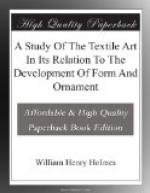By the free introduction of such elements textile ornament loses its pristine geometric purity and becomes in a measure degraded. In the more advanced stages of Pueblo art the ornament of nearly all the textiles is pervaded by ideographic characters, generally rude suggestions of life forms, borrowed, perhaps, from mythologic art. This is true of much of the coiled basketry of the Moki Indians. True, many examples occur in which the ancient or indigenous geometric style is preserved, but the majority appear to be more or less modified. In many cases nothing can be learned from a study of the designs themselves, as the particular style of construction is not adapted to realistic expression, and, at best, resemblances to natural forms are very remote. Two examples are given in Figs. 326 and 327. I shall expect, however, when the art of these peoples is better known, to learn to what particular mythic concept these mixed or impure geometric devices refer.
[Illustration: Fig. 326. Coiled tray with geometric devices probably modified by ideographic association. Moki work—1/4.]
The same is true of other varieties of Pueblo basketry, notably the common decorated wickerware, two specimens of which are given in Figs. 328 and 329. This ware is of the interlaced style, with radially arranged web filaments. Its geometric characters are easily distinguished from those of the coiled ware. Many examples exhibit purely conventional elaboration, the figures being arranged in rays, zones, checkers, and the like. It is to be expected, however, that the normal ornament of this class of products should be greatly interfered with through attempts to introduce extraneous elements, for the peoples have advanced to a stage of culture at which it is usual to attempt the introduction of mythologic representations into all art. Further consideration of this subject will be necessary in the next section of this paper.
[Illustration: Fig. 327. Coiled tray with geometric devices, probably modified by ideographic association. Moki work—1/4.]
[Illustration: Fig. 328. Tray of interlaced style of weaving, showing geometric ornament, probably modified by ideographic association. Moki work—1/4.]
The processes of pure geometric elaboration with which this section is mainly concerned can be studied to best advantage in more primitive forms of art.
[Illustration: Fig. 329. Tray of interlaced style of weaving, showing geometric ornament, probably modified by ideographic association. Moki work—1/4.]




